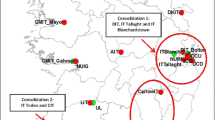Abstract
Spatial interaction modelling and geodemographic analysis have each developed as quite separate research traditions. In this paper, we present an integrated model that harnesses the power of spatial interaction modelling to behavioural insights derived from a geodemographic classification. This approach is applied to the modelling of participation in higher education (HE). A novel feature of the paper is the integration of national schools, colleges and HE data; a national model is then calibrated and tested against actual recorded flows of students into HE. The model is implemented within a Java framework and is presented as a first step towards providing a quantitative tool that can be used by HE stakeholders to explore policies relating to such topics as widening access to under-represented groups.







Similar content being viewed by others
References
Ashby DI, Longley PA (2005) Geocomputation, geodemographics and resource allocation for local policing. Trans GIS 9(1):53–72
Aveyard P, Manaseki S, Chambers J (2002) The relationship between mean birth weight and poverty using the townsend deprivation score and the super profile classification system. Public Health 116(6):308–314
Batey P, Brown PJB, Corver M (1999) Participation in higher education: a geodemographic perspective on the potential for further expansion in student numbers. J Geogr Syst 1(3):277–303
Birkin M (1995) Customer targeting, geodemographic and lifestyles approaches. In: Longley PA, Clarke GP (eds) GIS for business and service planning. Geoinformation, Cambridge, pp 104–149
Birkin M, Clarke G (1998) GIS, geodemographics, and spatial modeling in the UK financial service industry. J Hous Res 9(1):87–111
Birkin M, Clarke G, Clarke M (2002) Retail geography and intelligent network planning. Wiley, Chichester
Birkin M, Clarke G, Clarke M, Culf R (2003) Using spatial models to solve difficult retail location problems. In: Stillwell J, Clarke G (eds) Applied GIS and spatial analysis. Wiley, Chichester, pp 35–54
Black JA, Salter RJ (1975) A statistical evaluation of the accuracy of a family of gravity models. Proc Inst Civ Eng 59:1–26
Bowden R (2000) Fantasy higher education: university and college league tables. Qual High Educ 6(1):41–60
Bureau of Public Roads (1965) Calibrating and testing a gravity model for any size urban area. US Dept of Commerce—Bureau of Public Roads, Washington DC
Comptroller Auditor General (2008) Widening participation in higher education. National Audit Office, London
Erlander S, Stewart NF (1990) The gravity model in transportation analysis: theory and extensions. VSP BV, The Netherlands
Feng Z, Flowerdew R (1998) Fuzzy geodemographics: a contribution from fuzzy clustering methods. In: Carver S (ed) Innovations in GIS 5. Taylor & Francis, Oxford, pp 119–127
Fotheringham AS (1983) A new set of spatial interaction models: the theory of competing destinations. Environ Plan A 15(1):15–36
Fotheringham AS, Brunsdon C, Charlton M (2000) Quantitative geography: perspectives on spatial data analysis. Sage, London
Han Q, Timmermans H (2006) Towards models of strategic spatial choice behaviour: theory and application issues. GeoJournal 67(3):195–206
Harris R, Sleight P, Webber R (2005) Geodemographics, GIS and neighbourhood targeting. Wiley, Chichester
Harris R, Johnston R, Burgess S (2007) Neighborhoods, ethnicity and school choice: developing a statistical framework for geodemographic analysis. Popul Res Policy Rev 26(5–6):553–579
Longley PA (2005) Geographical information systems: a renaissance of geodemographics for public service delivery. Prog Hum Geogr 29(1):57–63
Singleton AD (2010) Educational opportunity: the geography of access to higher education. Ashgate, Farnham
Singleton AD, Longley PA (2009) Creating open source geodemographics—refining a national classification of census output areas for applications in higher education. Prog Hum Geogr 88(3):643–666
Sleight P (1997) Targeting customers: how to use geodemographic and lifestyle data in your business. NTC Publications, Henley-on-Thames
Stillwell JCH (1978) Interzonal migration: some historical tests of spatial interaction models. Environ Plan A 10:1187–1200
Tobler WR (1970) A computer movie simulating urban growth in the Detroit region. Econ Geogr 46(2):234–240
Tonks D, Farr M (2003) Widening access and participation in UK higher education. Int J Educ Manage 17(1):26–36
Turner D (2005) Benchmarking in universities: league tables revisited. Oxford Rev Educ 31(3):353–371
Twigg L, Moon G, Jones K (2000) Predicting small-area health-related behaviour: a comparison of smoking and drinking indicators. Soc Sci Med 50(7–8):1109–1120
Vickers D, Rees P (2007) Creating the UK national statistics 2001 output area classification. J R Stat Soc Ser A Stat Soc 170(2):379–403
Voas D, Williamson P (2001) The diversity of diversity: a critique of geodemographic classification. Area 33(1):63–76
Wilson AG (1970) Entropy in urban and regional modelling. Pion, London
Wilson AG (1998) Land-use/transport interaction models: past and future. J Transp Econ Policy 32(1):3–26
Wilson AG (2000) The widening access debate: student flows to universities and associated performance indicators. Environ Plan A 32(11):2019–2031
Author information
Authors and Affiliations
Corresponding author
Rights and permissions
About this article
Cite this article
Singleton, A.D., Wilson, A.G. & O’Brien, O. Geodemographics and spatial interaction: an integrated model for higher education. J Geogr Syst 14, 223–241 (2012). https://doi.org/10.1007/s10109-010-0141-5
Received:
Accepted:
Published:
Issue Date:
DOI: https://doi.org/10.1007/s10109-010-0141-5




